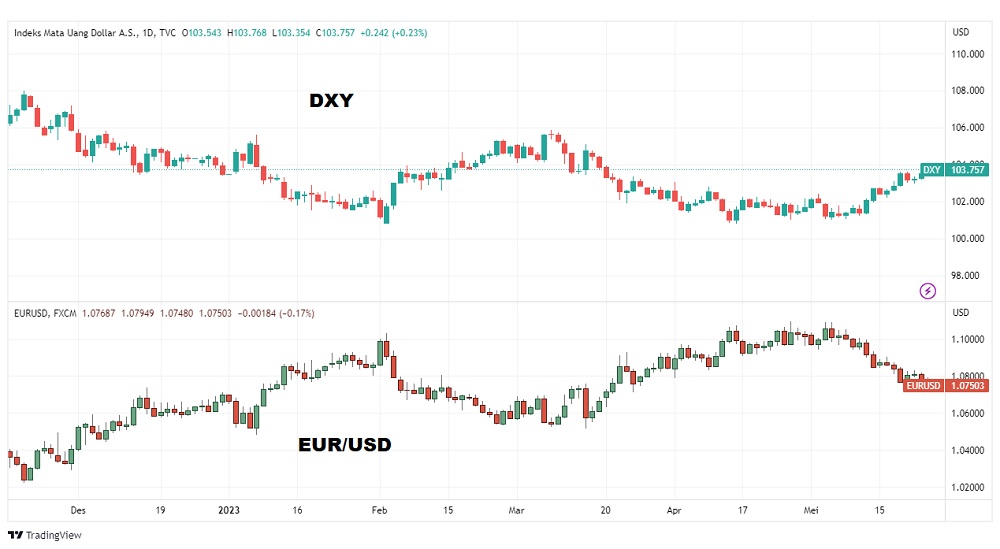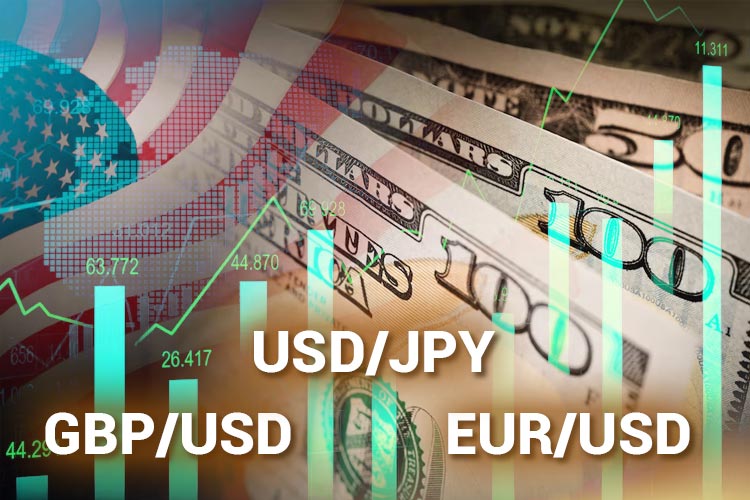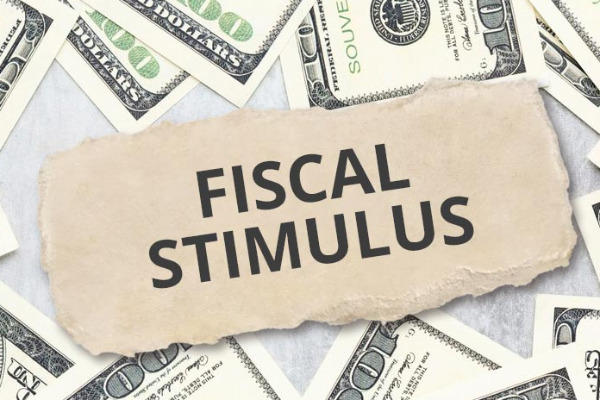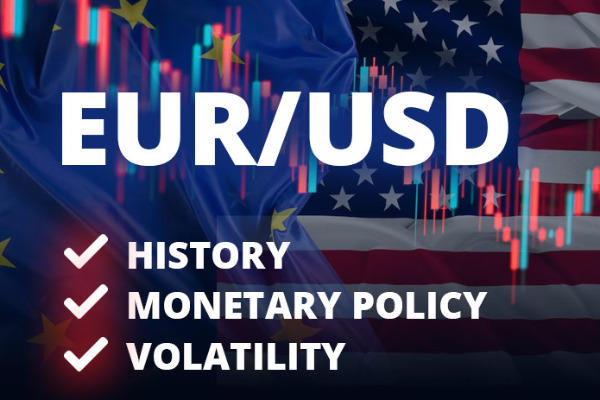When you are reading latest financial news in Bloomberg, Reuters, or others, you may see the word Dollar Index. What is it, and why is it being quoted so often?
US Dollar Index (USDX) is an index that follows the value of the US Dollar compared to a basket of other currencies, usually major currencies. It is a weighted geometric mean on relative value constructed by giving different weights to different currencies.
That being said, the US Index, often known as DXY plays an important part in the forex market. The US dollar index can offer valuable insights and implications for various traders.
The US Dollar index can be used in various trading analyses. But, the most popular way to use it is to analyze the EUR/USD, stock, and bond markets because it correlates negatively with those assets.
Besides its applications in various analyses, there is plenty of information traders should know about the US Dollar Index. Here are some of them.
Using the US Dollar Index in Analysis
US Dollar Index was started in March 1973. Its figures reflect US Dollar relative value compared to when the index started and US Dollar global strength. A rising US Dollar Index indicates a gain and lower index figures mean a weakened US Dollar.
In the standard US Dollar Index, Euro receive the biggest weight, while other currencies in the basket are the Japanese Yen, Pound Sterling, Canadian Dollar, Swedish Krona, and Swiss Franc. The composition is as follows:
- Euro (EUR) 57.6% weight
- Japanese yen (JPY) 13.6% weight
- Pound sterling (GBP) 11.9% weight
- Canadian dollar (CAD) 9.1% weight
- Swedish krona (SEK) 4.2% weight and
- Swiss franc (CHF) 3.6% weight
However, a rising US Dollar Index does not automatically mean the currency will go up across the charts. As you can see on the composition above, just a couple of currencies are on the basket.
There are still many other currencies outside of it. Its measure can be a good fundamental indicator, but you will still need other references to make decisions.
Still, it is a fairly good trend indicator, particularly on the EUR/USD pair. As the US Dollar Index puts its biggest weight on Euro, it often moves in a different direction than the EUR/USD.
Also, if USDX has risen for some time while other currencies also rise in their respective pairs, you might have to consider the possibility of a reversal shortly. Continuously rising USDX means a strong bullish trend with substantial backing from buyers in the market for the USD.
For a better understanding, check out this DXY and EUR/USD chart below:

In the DXY chart, it is shown that the market is currently on a downward trend. But it's slowly moving upwards. It's proving that the US dollar is growing weaker compared to its rival, but it is starting to gain strength again.
Now, let's see the EUR/USD chart. Meanwhile, it can be seen that the EUR/USD chart shows a different trend compared to the DXY. Instead of going down like the US dollar index, EUR/USD is going upwards and slowly going down towards the end. It is the exact opposite of the DXY chart.
Outside the forex market, stock and bond traders can also use USDX. An article in Investopedia about this matter revealed that the correlation coefficient calculated for the USDX versus the DJIA, Nasdaq, and S&P 500, is 0.35, 0.39, and 0.38, respectively.
The figures mean US Dollar Index is related to some degree to the stock market. Furthermore, apart from indicating US Dollar strength, USDX can also be traded as derivatives in the financial market, including Exchange-Traded Funds (ETFs), options, and mutual funds.
In addition to the information above, the US dollar index can offer valuable insights and implications for various stakeholders, including traders, investors, and policymakers.
Here's how it can be used in trading analysis:
Forex Trading
The U.S. Dollar Index is particularly relevant for forex traders as it helps gauge the strength of the U.S. dollar compared to other major currencies.
Traders can monitor the index to identify potential trading opportunities, correlations, and trends. For example, a rising USDX indicates dollar strength, suggesting potential currency pairs where the dollar may outperform or underperform.
International Trade and Commodities
The U.S. Dollar Index has implications for international trade and commodities markets. As the dollar strengthens or weakens, it affects the purchasing power of other currencies, impacting import and export competitiveness.
Commodities, such as gold and oil, are often priced in U.S. dollars, so changes in the USDX can influence their prices and demand.
Market Sentiment
The U.S. Dollar Index is market sentiment and risk appetite barometer. When the index rises, it may indicate a flight to safety or a risk-off sentiment as investors seek the perceived stability of the U.S. dollar.
Conversely, a falling USDX may signal increased risk appetite and a preference for riskier assets.
Policy and Central Bank Implications
Central banks and policymakers closely monitor the U.S. Dollar Index as part of their decision-making process.
Changes in the index can influence monetary policy decisions, including interest rate adjustments and currency interventions. Central banks may aim to manage their currencies' value relative to the U.S. dollar based on the USDX's movements.
Because of its unique position, the US dollar is often dubbed as a safe haven. But, Greenback isn't the only safe haven the markets favor. Gold also has the same position. Between gold and the US dollar, which one is the best safe haven?

 Dedicated FREE FOREX VPS
Dedicated FREE FOREX VPS Free FOREX Virtual Private Server
Free FOREX Virtual Private Server MT4 Demo Contest, Get $500
MT4 Demo Contest, Get $500 Sign Up for an Account, Claim 60% Deposit Bonus
Sign Up for an Account, Claim 60% Deposit Bonus Free MT4/MT5 VPS 2024
Free MT4/MT5 VPS 2024 Send E-mail and Get Free Merchandise
Send E-mail and Get Free Merchandise $1K Refer a Friend Bonus for Pepperstone Pro clients
$1K Refer a Friend Bonus for Pepperstone Pro clients Maximize Your Earnings with 100% Deposit bonus
Maximize Your Earnings with 100% Deposit bonus Trade to Win, $5,000 Monthly Demo Contest
Trade to Win, $5,000 Monthly Demo Contest Claim 30% + 15% Deposit Bonus from LiteFinance
Claim 30% + 15% Deposit Bonus from LiteFinance








